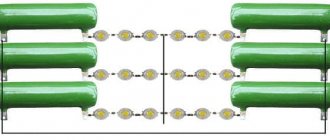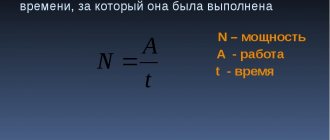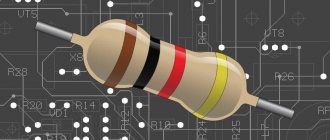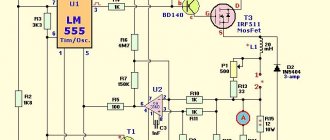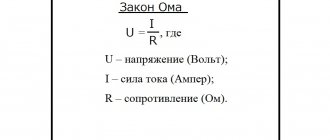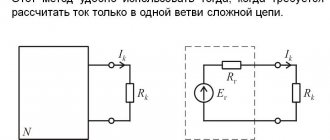Introduction
The resistors on this board from the power supply are circled in red rectangles and make up half of its elements
The term resistance is in some respects luckier than other physical terms: from early childhood we become familiar with this property of the world around us, mastering our environment, especially when we reach for a toy that we like in the hands of another child, and he resists it. This term is intuitively clear to us, therefore, during school years during physics lessons, getting acquainted with the properties of electricity, the term electrical resistance does not cause us any confusion and its idea is perceived quite easily.
The number of technical implementations of electrical resistance—resistors—produced in the world is incalculable. Suffice it to say that in the most common modern electronic devices - mobile phones, smartphones, tablets and computers - the number of elements can reach hundreds of thousands. According to statistics, resistors make up over 35% of the elements of electronic circuits, and given the scale of production of such devices in the world, we get a mind-boggling figure of tens of trillions of units. Along with other passive radioelements - capacitors and inductors, resistors form the basis of modern civilization, being one of the pillars on which our familiar world rests.
Cables should have the lowest possible electrical resistance
Definition
Electrical resistance is a physical quantity that characterizes certain electrical properties of matter that prevent the free passage of electric current through it without loss. In terms of electrical engineering, electrical resistance is the characteristic of an electrical circuit as a whole or a section of it to prevent the flow of current and is equal, at constant current, to the ratio of the voltage at the ends of the circuit to the current flowing through it.
Electrical resistance is concerned with the transfer or conversion of electrical energy into other forms of energy. When electrical energy is irreversibly converted into heat, we talk about active resistance. With the reversible conversion of electrical energy into the energy of a magnetic or electric field, if alternating current flows in the circuit, we speak of reactance. If inductance predominates in the circuit, we talk about inductive reactance, if capacitance, we talk about capacitive reactance.
The total resistance (active and reactive) for alternating current circuits is described in terms of impedance, and for alternating electromagnetic fields - by characteristic impedance. Resistance is sometimes not entirely correctly called its technical implementation - a resistor, that is, a radio component designed to introduce active resistance into electrical circuits.
Simple calculation examples
Household AC network
Example No. 1. Checking the heating element.
The washing machine has a built-in tubular electric heater 1.25 kW at 220 volts. It is necessary to check its serviceability by measuring the resistance. Based on power, we calculate current and resistance.
I = 1250 / 220 = 5.68 A; R = 220 / 5.68 = 38.7 Ohms.
We check the resistance calculation using a current and voltage calculator. The data matched. You can begin electrical measurements.
Example No. 2. Checking motor resistance
Let's say that we bought a 1.6 kilowatt washing vacuum cleaner for cleaning premises. We are interested in its current consumption and the resistance of the electric motor in operating condition. We count the current:
I = 1600 / 220 = 7.3 A.
We enter into the columns of the calculator a voltage of 220 volts and a current of 7.3 amperes. Let's start the calculation. We will automatically receive the data:
- motor resistance - 30.1 Ohm;
- power 1600 watts.
DC circuits
Let's calculate the filament resistance of a 55-watt halogen light bulb installed in a 12-volt car headlight.
We count the current:
I = 55 / 12 = 4.6 A.
We enter 12 volts and 4.6 amperes into the calculator. It calculates:
- resistance 2.6 ohms.
- power 5 watts.
Here I would like to draw your attention to the fact that if you measure the resistance in a cold state with a multimeter, it will be significantly lower.
This property of metals makes it possible to create simple and relatively cheap incandescent lamps without the complex ballasts required for LED and fluorescent lamps.
In other words: a change in the resistance of tungsten when heated to a red-hot state limits the increase in current through it. But when the metal is cold, an inrush of current occurs. It can cause the thread to burn out.
To extend the service life of such light bulbs, a gradual, smooth supply of voltage from zero to the nominal value is used.
As simple but reliable devices for cars, a current limiting relay circuit operating in steps is often used.
When the switch SA is turned on, the resistance of the resistor R limits the inrush of current through the cold filament. When it warms up, due to a change in the voltage drop across the HL1 lamp, the electromagnet with the relay winding KL1 will put its contact on hold.
It will bypass the resistor, which will render it unusable. The rated current of the circuit will flow through the filament.
Ohm's law
Resistance is designated by the letter R
or
r
and is considered, within certain limits, a constant value for a given conductor; it can be calculated as
Ohm's law
R = U/I
Where
R—resistance, Ohm;
U is the electrical potential difference (voltage) at the ends of the conductor, V;
I is the current strength flowing between the ends of the conductor under the influence of a potential difference, A.
This formula is called Ohm's law, named after the German physicist who discovered this law. An important role in calculating the thermal effect of active resistance is played by the law on the heat generated when an electric current passes through the resistance - the Joule-Lenz law:
Q = I2 R t
Where
Q is the amount of heat released over a period of time t, J;
I—current strength, A;
R—resistance, Ohm;
t — current flow time, sec.
Georg Simon Ohm
Useful information for a novice electrician
How to use Ohm's law in practice
Almost two centuries ago, back in 1827, through his experiments, Georg Ohm revealed a pattern between the main characteristics of electricity.
He studied and published the effect of the resistance of a section of a circuit on the amount of current produced under the influence of voltage. It is convenient to present it with a visual picture.
Any work is always created by an electric current. It rotates the rotor of an electric motor, causes a light bulb to glow, welds or cuts metals, and performs other actions.
Therefore, he needs to create optimal conditions: the magnitude of the electric current must be maintained at the nominal level. It depends on:
- the voltage applied to the circuit;
- resistance of the medium through which the current flows.
Here, voltage, as the potential difference of applied energy, is the force that creates electric current.
If there is no voltage, then no useful work will occur from the connected electrical circuit due to the lack of current. This situation often occurs when the supply wire is broken, broken, or burnt out.
Resistance solves the inverse problem for voltage. At a very large value, it limits the current so much that it is unable to do any work. This mode is used for good dielectrics.
Historical reference
The first researcher of the phenomenon of electrical resistance, and, subsequently, the author of the famous law of the electrical circuit, later named after him, was the outstanding German physicist Georg Simon Ohm. Published in 1827 in one of his papers, Ohm's law played a decisive role in the further study of electrical phenomena. Unfortunately, his contemporaries did not appreciate his research, like many of his other works in the field of physics, and, by order of the Minister of Education, he was even fired from his post as a mathematics teacher in Cologne for publishing the results of his research in newspapers. And only in 1841, after the Royal Society of London awarded him the Copley Medal at a meeting on November 30, 1841, recognition finally came to him. Taking into account the merits of Georg Ohm, in 1881, at the international congress of electricians in Paris, it was decided to name the now generally accepted unit of electrical resistance (“one ohm”) after him.
Formulation and explanation of Ohm's law
The law of the German teacher Georg Ohm is very simple. It reads:
The current strength in a section of the circuit is directly proportional to the voltage and inversely proportional to the resistance.
Georg Ohm derived this law experimentally (empirically) in 1826 . Naturally, the greater the resistance of the circuit section, the less current will be. Accordingly, the higher the voltage, the greater the current.
By the way! For our readers there is now a 10% discount on any type of work
This formulation of Ohm's law is the simplest and is suitable for a section of a circuit. By saying “circuit section” we mean that this is a homogeneous section in which there are no current sources with EMF. To put it simply, this section contains some kind of resistance, but there is no battery on it that provides the current itself.
If we consider Ohm's law for a complete circuit, its formulation will be slightly different.
Let us have a circuit, it has a current source that creates voltage, and some kind of resistance.
The law will be written as follows:
The explanation of Ohm's law for a hollow chain is not fundamentally different from the explanation for a section of a chain. As you can see, the resistance consists of the resistance itself and the internal resistance of the current source, and instead of voltage, the electromotive force of the source appears in the formula.
By the way, read about what EMF is in our separate article.
Physics of phenomena in metals and its application
According to their properties and relative resistance values, all materials are divided into conductors, semiconductors and insulators. A separate class are materials that have zero or close to zero resistance, the so-called superconductors. The most typical representatives of conductors are metals, although their resistance can vary widely, depending on the properties of the crystal lattice.
According to modern concepts, metal atoms combine into a crystal lattice, and the so-called “electron gas” is formed from the valence electrons of the metal atoms.
Burnout of an incandescent lamp filament in the air
The relatively low resistance of metals is due precisely to the fact that they contain a large number of current carriers - conduction electrons - belonging to the entire ensemble of atoms of a given metal sample. Arising when an external electric field is applied, the current in the metal represents the ordered movement of electrons. Under the influence of the field, electrons are accelerated and acquire a certain momentum, and then collide with lattice ions. During such collisions, electrons change momentum, partially losing the energy of their movement, which is converted into the internal energy of the crystal lattice, which leads to heating of the conductor when an electric current passes through it. It should be noted that the resistance of a sample of metal or metal alloys of a given composition depends on its geometry, and does not depend on the direction of the applied external electric field.
Further application of an increasingly stronger external electric field leads to an increase in current through the metal and the release of more and more heat, which can ultimately lead to melting of the sample. This property is used in wire fuses for electrical circuits. If the temperature exceeds a certain norm, the wire melts and interrupts the electrical circuit - current can no longer flow through it. The temperature standard is ensured by choosing the material for the wire according to its melting point. An excellent example of what happens to fuses comes from filming a filament burning out in an ordinary incandescent lamp.
The most typical application of electrical resistance is as a fuel element. We use this property when cooking and heating food on electric stoves, baking bread and cakes in electric ovens, as well as when working with electric kettles, coffee makers, washing machines and electric irons. And we don’t think at all that for our comfort in everyday life, we must again be grateful to electrical resistance: whether we turn on a boiler for a shower, or an electric fireplace, or an air conditioner in the mode of heating the air in the room - in all these devices there is always a heating element based on electric resistance.
In industrial applications, electrical resistance ensures the preparation of semi-finished food products (drying), chemical reactions at the optimal temperature to obtain dosage forms, and even in the manufacture of completely prosaic things, such as plastic bags for various purposes, as well as in the production of plastic products (extrusion process).
Volts, watts and ohms - how do they affect the operation of electronic cigarettes?
An attentive smoker of e-cigarettes has definitely noticed that the range of e-cigarettes in stores is rapidly expanding - there are both simple disposable sticks and complex models with colored buttons, disks and displays. In order to simplify our life, make it more convenient and enjoyable, these “gadgets” are also constantly evolving. Next, we will talk about the latest models of e-cigarettes, which allow the user to independently regulate the amount of vapor, intensity of puff and taste.
Since everyone's tastes and habits are different, experts have developed e-cigarettes that allow the user to independently adjust the puff strength, amount of vapor, and flavor intensity. One person likes soft and easy communication with an e-cigarette, another prefers a serious “exhaust”, otherwise the e-cigarette will not satisfy his smoker’s appetite, and something in between suits the third.
In this article, we'll look at the combined effects of resistance (Ohms), voltage (Volts), and power (Watts) and learn that lower resistance and higher voltage produce more vapor, stronger exhaust, and more intense flavor.
However, before starting a physics lesson, it is worth noting that in reality, an e-cigarette user, even without special physical knowledge, can easily cope with tension and resistance without delving too deeply into scientific research.
Resistance (Ohm Ω)
What is Om? Ohm is a unit of resistance. The lower the resistance of your e-cigarette's vaporizer, the more current passes through it. If you increase the resistance level, then the same amount less current will pass through the evaporator.
What resistance is best to use? It depends on your preferences - how intense of flavor and kick do you prefer? Also depends on what ratio of voltage (Volts) to resistance (Ohms) you use. However, different e-liquids behave differently, and the use of different resistances affects the taste. Therefore, to achieve optimal qualities of an e-cigarette, experimentation will be required. Next, we will present the properties of an e-cigarette when using an evaporator with different resistance.
When using an evaporator with low resistance, there will be more current, therefore:
- More heat is generated in the heating element
- More steam generated
- The taste is less intense
- Steam is warmer
- Battery drains faster
- Battery life decreases
- E-liquid runs out faster The lifespan of the evaporator is reduced (a evaporator with very low resistance can only last 2-3 days)
- There is a high probability that you will get a “dry hit”
When using an evaporator with high resistance, the opposite effect occurs:
- Less current passes through the heating element
- The evaporator heats up less
- Less steam
- Steam is colder
- Steam with more intense flavor
- Battery life increases
- Less e-liquid consumption (lasts a long time)
- It is unlikely that you will get a "dry hit"
Variable voltage (V) and power (W)
The resistance of the evaporator is not the only thing that controls the amount of vapor, the intensity of the flavor and the "blow" - it also depends on the power produced by the battery (W) in the evaporator.
There are 2 main types of e-cigarette batteries that allow you to change the current in the evaporator - batteries with variable voltage (VV - variable voltage) and batteries with variable power (VW - variable wattage). For example, Nicorex offers an Ola 2200 mAh battery.
As stated above, the vapor intensity of an e-cigarette can be increased by decreasing the resistance of the evaporator or increasing the current passing through your e-cigarette. This may seem complicated, but it's really not difficult at all - you just need to press the up-down button or adjust the rotary dial.
What to do if you want to increase the amount of steam again? In this case, you can combine a low resistance evaporator with a high voltage (V) battery to produce even more vapor. However, this can cause problems: if you adjust it too high, the vaporizer may overheat and you may get a “dry hit.” In any case, the service life of the evaporator will be sharply reduced.
Variable voltage (V) devices vs. variable power (W) devices
The difference between variable voltage (VV) and variable power (VW) can be compared to the difference between an automatic transmission and a manual transmission.
In a variable voltage (VV) device, the voltage can be manually adjusted - in this case, the final output depends on the resistance of the specific evaporator. With a variable wattage (VW) device, you only need to adjust the wattage to the desired level and the battery increases the voltage automatically according to the resistance of the evaporator. The battery itself recognizes the resistance of the evaporator and regulates the voltage accordingly. In this case, the same power is always provided, regardless of the evaporator resistance. Thus, as power (W) increases, voltage (V) also increases, and vice versa.
For example, if you use a vaporizer with a 1.8 ohm heating element that operates at 3.7 volts, you'll get about 7.3 watts of output—that's a good puff.
However, if you set the heating element to a resistance higher than 2.8 ohms, you will notice a significant reduction in flavor, vapor, and heat because the wattage (W) is lower (about 4.4 watts) and you will have to increase the voltage to increase the wattage (W). (V) - then you will get a good puff. Heating elements with lower resistance use more power (W), they tend to produce more heat and therefore can overheat faster than heating elements with higher resistance.
What does mAh mean on an e-cigarette battery?
You have probably noticed the designation “mAh” in the descriptions of various electronic cigarette batteries. mAh essentially tells you how long a battery can last. If we return to the car analogy, then if voltage (V) is the fuel, then mAh is the size of the fuel tank: the larger the tank, the longer you can drive. mAh means milliamps per hour and shows the capacity of the battery: the higher this value, the longer the battery can last.
Physics of phenomena in semiconductors and its application
In semiconductors, unlike metals, the crystal structure is formed due to covalent bonds between the atoms of the semiconductor and therefore, unlike metals, in their pure form they have a significantly higher electrical resistance. Moreover, if they talk about semiconductors, they usually mention not resistance, but their own conductivity.
Microprocessor and video card
The introduction of impurities of atoms with a large number of electrons on the outer shell into a semiconductor creates n-type donor conductivity. In this case, the “extra” electrons become the property of the entire ensemble of atoms in a given semiconductor sample and its resistance decreases. Similarly, introducing into a semiconductor impurities of atoms with a smaller number of electrons on the outer shell creates p-type acceptor conductivity. In this case, the “missing” electrons, called “holes,” become the property of the entire ensemble of atoms in a given semiconductor sample and its resistance also decreases.
The most interesting case is the connection of semiconductor regions with different types of conductivity, the so-called pn junction. This transition has the unique property of anisotropy - its resistance depends on the direction of the applied external electric field. When the “blocking” voltage is turned on, the boundary layer of the pn junction is depleted of conduction carriers and its resistance increases sharply. When an “opening” voltage is applied in the boundary layer, conduction carriers recombine in the boundary layer and the resistance of the pn junction sharply decreases.
The most important elements of electronic equipment—rectifier diodes—are built on this principle. Unfortunately, when a certain current through the pn junction is exceeded, a so-called thermal breakdown occurs, in which both donor and acceptor impurities move through the pn junction, thereby destroying it, and the device fails.
The main conclusion about the resistance of pn junctions is that their resistance depends on the direction of the applied electric field and is nonlinear, that is, it does not obey Ohm’s law.
The processes occurring in MOS transistors (Metal-Oxide-Semiconductor) are of a slightly different nature. In them, the source-drain channel resistance is controlled by the electric field of the appropriate polarity for p- and n-type channels created by the gate. MOSFETs are used almost exclusively in the on-off switch mode and make up the vast majority of electronic components in modern digital technology.
Regardless of their design, all transistors in their physical essence are, within certain limits, inertia-free controlled electrical resistances.
In a xenon flash lamp (circled in red), the flash occurs after the gas is ionized as a result of a decrease in its electrical resistance
Physics of phenomena in gases and its application
In their normal state, gases are excellent dielectrics because they have a very small number of charge carriers - positive ions and electrons. This property of gases is used in contact switches, overhead power lines and air capacitors, since air is a mixture of gases and its electrical resistance is very high.
Since the gas has ionic-electronic conductivity, when an external electric field is applied, the resistance of the gases initially slowly decreases due to the ionization of an increasing number of molecules. With a further increase in the external field voltage, a glow discharge occurs and the resistance changes to a steeper voltage dependence. This property of gases was previously used in gas-filled lamps - stabistors - to stabilize direct voltage over a wide range of currents. With a further increase in the applied voltage, the discharge in the gas turns into a corona discharge with a further decrease in resistance, and then in a spark discharge - a small lightning appears, and the gas resistance in the lightning channel drops to a minimum.
The main component of the Terra-P radiometer-dosimeter is the Geiger-Muller counter. Its operation is based on the impact ionization of the gas contained in it when hit by a gamma quantum, as a result of which its resistance sharply decreases, which is recorded.
The property of gases to glow when current flows through them in a glow discharge mode is used for the design of neon advertisements, alternating field indications and in sodium lamps. The same property, only when mercury vapor glows in the ultraviolet part of the spectrum, ensures the operation of energy-saving lamps. In them, the luminous flux of the visible spectrum is obtained as a result of the conversion of ultraviolet radiation by a fluorescent phosphor with which the lamp bulbs are coated. The resistance of gases, just like in semiconductors, has a nonlinear dependence on the applied external field and also does not obey Ohm’s law.
Physics of phenomena in electrolytes and its application
The resistance of conducting liquids - electrolytes - is determined by the presence and concentration of ions of different signs - atoms or molecules that have lost or gained electrons. When there is a lack of electrons, such ions are called cations; when there is an excess of electrons, they are called anions. When an external electric field is applied (electrodes with a potential difference are placed in the electrolyte), cations and anions begin to move; the physics of the process consists of discharging or charging ions at the appropriate electrode. In this case, at the anode, the anions give up excess electrons, and at the cathode, the cations receive the missing ones.
Galvanic chrome coating of plastic shower head. A thin red layer of copper is visible on the unchromed inner side.
A significant difference between electrolytes and metals, semiconductors and gases is the movement of substances in electrolytes. This property is widely used in modern technology and medicine - from purifying metals from impurities (refining) to introducing medicines into a diseased area (electrophoresis). The sparkling plumbing of our baths and kitchens comes from electroplating processes such as nickel and chrome plating. It is unnecessary to remember that the quality of the coating is achieved precisely by controlling the resistance of the solution and its temperature, as well as many other parameters of the metal deposition process.
Since the human body, from a physical point of view, is an electrolyte, knowledge of the human body’s resistance to the flow of electric current plays an essential role in relation to safety issues. Although the typical value of skin resistance is about 50 kOhm (weak electrolyte), it can vary depending on the psycho-emotional state of the individual and environmental conditions, as well as the area of skin contact with the electrical conductor. Under stress and anxiety or when in uncomfortable conditions, it can decrease significantly, so for safety calculations of human resistance, a value of 1 kOhm is adopted.
It is curious that based on measuring the resistance of various areas of human skin, the method of operation of the polygraph is based - a “lie detector”, which, along with the assessment of many physiological parameters, determines, in particular, the deviation of resistance from current values when asking the subject “uncomfortable” questions. True, this method is of limited applicability: it gives inadequate results when applied to people with unstable psyches, to specially trained agents, or to people with abnormally high skin resistance.
Within certain limits, Ohm's law is applicable to the current in electrolytes; however, when the external applied electric field exceeds certain values characteristic of a given electrolyte, its resistance is also nonlinear.
Many people still prefer tube amps for their warm, so-called "tube sound." This compact tube amplifier for the Jolida Glass FX 10 guitar is made using Russian-made 6N2P and 6P14P tubes.
A Guide to Watts, Ohms and Resistance in Electronic Cigarettes
To vape safely, you need to understand a few basic laws of electricity. Here you will find the terms Voltage, Volts, Current, Amps, Resistance, Ohms, Power, Watts and Ohm's Law itself. In this guide, we explain what this means and why a vaper needs it.
Voltage, volts, V
As a rule, a fully charged battery should have a voltage of 4.2 Volts. This can be understood as the amount of energy pushing electricity through your device, evaporating liquid and creating steam. You can think of this as water pressure. As water is drained from the tank, less water remains, the “pressure” becomes less, and the flow decreases.
Current strength, Ampere, A (Current, Amps, A)
Current is the “flow” of electricity. The faster it flows, the faster the battery drains. Additionally, the faster it flows, the hotter the coil in your vaporizer becomes, and the more vapor the e-liquid produces. The variable power/voltage device (board) will keep the current flowing at a constant rate by "pushing" it.
Resistance, Ohms, Ω
Increasing resistance slows down electrical flow. More resistance means colder vape. This is achieved by using a thinner wire, but this means there is less wire contact with the wick, which can reduce the amount of flavor and produce much less vapor. Lower resistance is obtained by using thicker or flatter wire, complex winding, or an evaporator with a mesh inside.
Ohm's law
To determine the maximum current flowing through the evaporator, divide 4.2 by the resistance value of the coil (or replacement head) you are using. To calculate which winding is safe to use, divide 4.2 by the maximum current the battery can handle (be sure to check this data and make sure your battery is not a “Chinese copy”). The best batteries are capable of delivering a current of 30-35 Amperes, and the Chinese - no more than 3-5.
Power, Watts, W
Power is the rate at which energy is transferred from the battery to the evaporator. Power shows how much energy the board consumes for a certain unit of time. Variwatt is almost universally used in modern devices. This is a mode in which constant power is maintained despite the voltage drop during battery discharge.
Translation and adaptation | Zuncl Original article | ecigclick.co.uk Photos | aleksandryu & awdei1992
If you find an error, highlight it and press Ctrl+Enter .
Physics of phenomena in dielectrics and its application
The resistance of dielectrics is very high, and this quality is widely used in physics and technology when used as insulators. An ideal dielectric is a vacuum and, it would seem, what kind of resistance in a vacuum can we talk about? However, thanks to one of Albert Einstein’s works on the work function of electrons from metals, which was undeservedly ignored by journalists, in contrast to his articles on the theory of relativity, humanity gained access to the technical implementation of a huge class of electronic devices that marked the dawn of radio electronics, and is still working properly to this day serving people.
Magnetron 2M219J installed in a household microwave oven
According to Einstein, any conducting material is surrounded by a cloud of electrons, and these electrons, when an external electric field is applied, form an electron beam. Vacuum two-electrode devices have different resistance when changing the polarity of the applied voltage. Previously, they were used to rectify alternating current. Three or more electrode tubes were used to amplify the signals. Now they are being replaced by more energy-efficient transistors.
However, there remains an area of application where devices based on an electron beam are absolutely irreplaceable - these are X-ray tubes, magnetrons used in radar stations and other electric vacuum devices. Engineers to this day peer into the screens of oscilloscopes with cathode ray tubes, determining the nature of the physical processes taking place, doctors cannot do without X-rays, and we all use microwave ovens every day, which contain microwave emitters - magnetrons.
Since the nature of conductivity in a vacuum is only electronic in nature, the resistance of most electric vacuum devices obeys Ohm's law.
Surface Mount Resistors
FAQ
How many Watts are in Ampere?
If we are talking about a car network, then in one ampere there are 12 watts at a voltage of 12V
.
In a household electrical network of 220 Volts
, a current of 1 ampere will be equal to the consumer power of
220 Watts
, but if we are talking about an industrial network of
380 Volts
, then
657 Watts per ampere
.12 amps how many watts?
How many watts of power at 12 amperes of current consumption will depend on the network voltage with which the consumer himself operates. So 12A it could be: 144 Watts in a 12V car network; 2640 Watts in a 220V network; 7889 Watts on a 380 Volt power supply.
220 watts how many amps?
The current strength of a 220 Watt consumer will differ depending on the network in which it operates. This can be: 18A at a voltage of 12 Volts, 1A if the voltage is 220 Volts, or 6A when current consumption occurs in a 380 Volt network.
Resistors: their purpose, application and measurement
Variable adjustment resistor
A resistor (English resistor, from Latin resisto - I resist) is an element of an electrical circuit intended to be used as electrical resistance. In addition, resistors, being the technical implementation of electrical resistance, are also characterized by parasitic capacitance, parasitic inductance and nonlinearity of the current-voltage characteristic.
A resistor is an electronic device needed in all electronic circuits. According to statistics, 35% of any radio circuit consists of resistors. Of course, you can try to come up with a circuit without resistors, but these will only be mind games. Practical electrical and electronic circuits without resistors are unthinkable. From the point of view of an electrical engineer, any device that has resistance can be called a resistor, regardless of its internal structure and method of manufacture. A striking example of this is the story of the crash of the airship “Italy” of the polar explorer Nobile. The expedition's radio operator managed to repair the radio station and send a distress signal, replacing the broken resistor with a pencil lead, which ultimately saved the expedition.
10 watt ceramic resistor
Resistors are elements of electronic equipment and can be used as discrete components or components of integrated circuits. Discrete resistors are classified by purpose, type of current-voltage characteristic, method of protection and installation method, nature of resistance change, manufacturing technology and dissipated thermal energy. The resistor designation in the circuits is shown in the figure below:
Resistors can be connected in series or in parallel. When resistors are connected in series, the total resistance of the circuit is equal to the sum of the resistances of all resistors:
R = R1 + R2 + … + Rn
When resistors are connected in parallel, their total circuit resistance is equal to
R = R1 R2 … Rn/(R1 + R2 + … + Rn)
According to their purpose, resistors are divided into:
- general purpose resistors;
- resistors for special purposes.
According to the nature of the change in resistance, resistors are divided into:
- fixed resistors;
- variable adjustment resistors;
- variable tuning resistors.
Trimmer resistor designed for installation on a printed circuit board
By installation method:
- for printed circuit installation;
- for wall-mounted installation;
- for microcircuits and micromodules.
According to the type of current-voltage characteristic:
- linear resistors - typically general purpose resistors designed to divide voltage, limit current, and dissipate power;
- varistors - resistance depends on the applied voltage and drops sharply when the operating threshold is reached; they are used to protect equipment from pulse overvoltages (interference) and fast transients (voltage surges);
- thermistors - resistance depends on temperature; there are thermistors with a negative (thermistors) and positive (posistors) temperature coefficient of resistance (TCR). They are the basis for temperature measurement and control systems, fire safety systems and temperature compensation circuits. In the recent past, they have been widely used for power measurement in high-frequency technology. Turning on an old TV on a cathode ray tube (kinescope), due to a posistor with a demagnetization loop, we get an alternating magnetic field that is attenuated in amplitude, and therefore there are no color distortions on the kinescope due to accidental magnetization;
- photoresistors - resistance depends on illumination, used as light sensors in tracking and automation devices, as well as in household photo relays, in security systems; we use them without noticing it, passing through the subway turnstiles and automatic entrance doors;
- magnetoresistors - resistance depends on the magnitude of the magnetic field; they are used to measure magnetic induction, power, as sensitive elements of contactless switches, linear displacement sensors, Hall sensors and contactless potentiometers.
0.5 watt resistors on tape
Color coding of resistors
Depending on the dimensions and purpose of the resistors, digital symbolic markings or markings with colored stripes for surface-mounted or printed-circuit mounted resistors are used to indicate their ratings. The symbol in the marking can play the role of a comma in the denomination designation: the symbols R and E are used to denote Ohm, the symbol K is used for kiloohms, and the symbol M is used for megaohms. For example: 3R3 means a nominal value of 3.3 Ohms, 33E = 33 Ohms, 4K7 = 4.7 kOhm, M56 = 560 kOhm, 1M0 = 1.0 Mohm.
Color coding of resistors
Measuring resistor resistance using a multimeter
For small-sized wall-mounted and printed resistors, marking with colored stripes is used according to available tables. In order not to rummage through reference books, you can find many different programs on the Internet for determining the resistor value.
Surface mount resistors (SMD) are marked with three or four numbers or three symbols; in the latter case, the value is also determined using a table or special programs.
